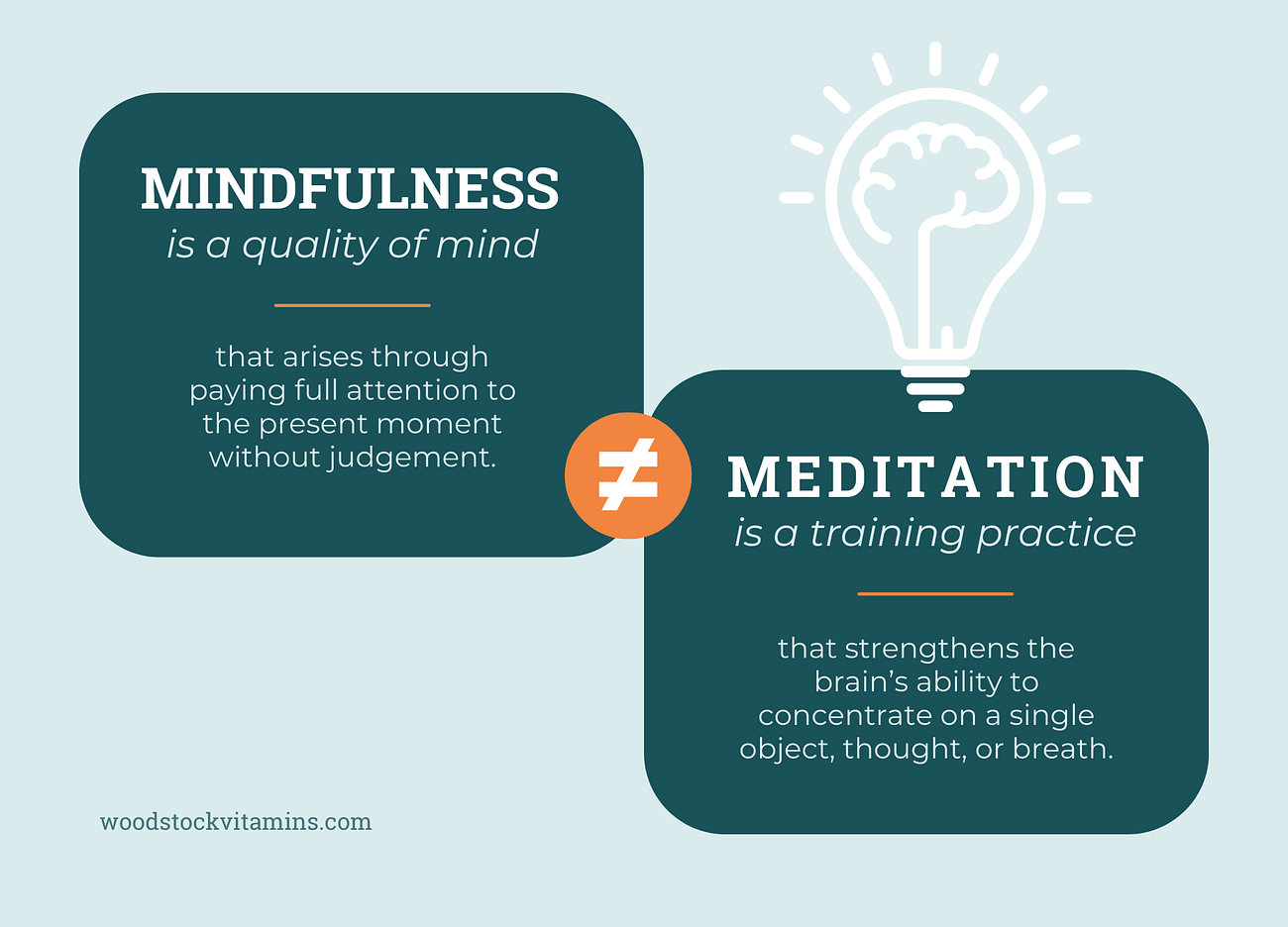
It wouldn’t be 7:30AM on a random Wednesday in February if we didn’t wake up with racing thoughts about traffic, work, sustenance, chores, past situations, family patterns, future anxieties, and everything in between, now would it?
An overly prolix sentiment, sure, but we stand by the fact that most of us contemporary humans suffer from what the experts call monkey brains.

Which refers to the fact our thoughts can be a chaotic, overwhelming, overlapping cacophony of voices, each ringing out to be heard or else whizzing past us at the speed of light.
Our thoughts, unlike our outward presentations of self, lack discipline — they careen around, creating complexes, thought loops, emotional spirals, and neural pathways so deeply entrenched we call them personality traits. What’s a modern thinker to do?
If you ask the internet, your options are medication or meditation. When it comes to the latter, though, something interesting happens: The internet and the professional medical community agree.
The meditation and mindfulness practices you hear excruciatingly self-righteous folks talk about do actually work for the woes of the modern human experience.
But before you dive in headfirst, it’s important to sift fact from fiction in the realm of mindfulness marketing. Not every approach to meditation is the mind-blowing miracle cure it claims to be. Read on to learn from both Dr. Neal and his colleague Dr. Lawrence Dresdale, a clinical psychologist, to find lasting peace of mind.
If you have access to the World Wide Web, there’s a 0% chance you haven’t heard of meditation and/or mindfulness.
The terms aren’t well understood though, which becomes apparent when you see them being used interchangeably. As Dr. Dresdale would say — and did, in this podcast episode — mindfulness and meditation are different but interrelated.
It might seem like semantics, but understanding the intricacies of these two practices is important if you want to actually benefit from one or both. Whether we admit to it or not, we all have preconceived notions about what meditation or mindfulness is; education combats these presumptions.
Dr. Dresdale draws from the work of Jon Kabat-Zinn — an American professor often regarded as the father of modern mindfulness — in his definition of what a mindful experience is.
It goes a little something like: Mindfulness is a quality of mind. This quality or state of mind arises through paying attention, on purpose, to the present moment, non-judgmentally. (We highly recommend you feast your ears on the ultra-calming resonance that is Dr. Dresdale’s voice in this podcast episode and hear it in his own words.)
Meditation, on the other hand, is a training practice.
In meditation, we are training or conditioning our brains to be able to hold attention on an object. That object can be a literal, physical object, or it can be your breath, a mantra, a sound, etc. Meditation counteracts the undisciplined nature of the brain by allowing us to develop the ability to concentrate.

But meditation and mindfulness play well together.
When we make time to develop our concentration skills in meditation, it becomes easier to reach the quality of mind in which we are fully concentrated on the present moment. Not that moment, not the next one, just this one.
Framing meditation as a kind of training program or neural workout plan relieves a little of the pressure to be perfect at it, right?
If you’ve been living in monkey brain mode, as most of us have for all our lives, then it makes sense that zen status feels difficult, strange, uncomfortable, or downright impossible at first. Which brings us to our first debunk of the two most widely-touted, wildly misplaced misconceptions about meditation:
For a long while, meditation has been portrayed in pop culture and profit-hungry wellness companies as a way of clearing your thoughts. Which sounds great — who wouldn’t want to be freed from the circus that is their internal monologue?
But that sets up unrealistic expectations, which can lead to frustration, and it’s not an accurate representation of the objective(s) of meditation. Meditation can, however, cultivate our focus and concentration capabilities. Then, with enough practice, our refined ability to concentrate can, eventually, lead us to that illustrious quiet place, the still mind.
The road to the still mind is long, albeit paved with a myriad of fringe benefits, and at some point on the journey, your nose is going to itch. The itch — or a thought, noise, emotion, interruption — will grab your attention and it’s not your job to clear your mind of it.

In fact, Dr. Dresdale recommends leaning into it. Focus on the itch, the numb leg, the discomfort, and draw that experience into your concentration training. When it passes, go back to your breath, mantra, or object.
If you had never played tennis before, would you beat yourself up for holding the racquet wrong? If it were your first day as a newborn on Earth, would you blame yourself for crapping your pants?
All this is to say that it’s okay to suck at new things! Meditation is a training practice because it takes training and practice to cultivate the skill of concentration.
And that it can be really scary to confront our innermost thoughts. So scary, in fact, that many people perceive themselves as failing at meditation if they can’t clear their minds or find everlasting peace the first or even 50th time they try.
But here’s the good news: Trying, or putting in an active effort, is what makes someone good at meditation. The people who are “good” at meditation are the ones who create time for it, sit down (or stand, walk, lay!), and try their best.
Struggling to contain your thoughts, losing track of your breathing, getting overwhelmed by emotions that come up, falling asleep — these are all things that can, and likely will, happen in a “good” meditation practice. If they do come up for you, it’s no big deal! Come back to your breath, try again tomorrow, and treat yourself compassionately.
In essence, we can use meditation to train our brains to respond to external stimuli instead of reacting by cultivating our ability to concentrate despite discomfort. That’s a pretty neat feature of being human on its own, but when coupled with mindfulness, it takes on a new, even more potent nature.
But you don’t have to combine meditation and mindfulness if you don’t want to. And in fact, there are a couple more misconceptions about mindfulness that we’d also like to clear up:
We won’t pretend that you’re not already at least a little disillusioned by life — we respect you, reader, more than that.
You already know that not every moment is going to be pretty and peaceful, leaving you pleased as punch. So the next time you see someone claim that expressing emotions, having unchill thoughts, or being generally not zen isn’t mindful — don’t buy it.
Mindfulness, as stated, involves an awareness of the reality of the present moment and everything that entails. Nose itches, big feelings, sensory input, and all. And actually, papering over discomfort is a hallmark of what we could call mindless experiences.
Like substance use or doom scrolling.
Understanding this aspect of mindfulness is important, and not just because self-compassion is a huge component of being mindful. It’s crucial that, during your journey toward mindfulness, you remember that every moment is an opportunity to begin again.
The discomfort of that previous moment might not be present in this current one if we are willing to let go and try again here and now. So what if you were unchill a second ago, that moment is gone.
There’s a new one right here.

Are the people who say, “Just be mindful,” as if it’s no big deal…kind of right? Yes and no.
Mindfulness is simple because all it requires from us is an awareness of all that there is. Which is, of course, only this present moment.
But simple and easy aren’t synonymous in this realm. Mindfulness is quite hard, especially in the digital age, because there’s a constant stream of wayward stimuli and willful thoughts pulling us out and away from the present moment.
Thankfully, getting a grasp on the difference between simple and easy in the case of mindfulness makes self-compassion more accessible. You’re doing a brave and difficult thing, after all! And, to make it simpler if not easier, it’s not actually your job to remove the obstacles to mindfulness in life.
Your only job, as Dr. Dresdale would wisely intone, is to train yourself to notice when your attention has wandered. That’s why meditation as training, while not required for mindfulness, can make the practice easier — yes, easier — with, well, practice.
Want more of the expert knowledge shared in this blog, straight from the horses — or, doctors’ — mouths? Spend a little time mindfully learning more about mindfulness with the original podcast episode featuring Dr. Neal and Dr. Lawrence Dresdale.
Or you know, click around a bit. It might not be the most meditative activity, but there are worse ways to spend your time than reading about the gut-brain connection or how to manage stress for better sleep. And if all else fails to satiate your appetite for meditation-related talk, give us a call via our free Counterside Consults for direct, personal guidance on your mindfulness journey.

Shop the Vital 5
Peek behind the curtain of supplement industry misinformation and enjoy special promotions, podcast episodes, and our No-BS approach to holistic care, sent weekly.

We built the model for finding supplements that work for your wellness, your wallet, and the world. Learn More
Peek behind the curtain of supplement industry misinformation and enjoy special promotions, podcast episodes, and our No-BS approach to holistic care, sent weekly.

We built the model for finding supplements that work for your wellness, your wallet, and the world. Learn More
These statements have not been evaluated by the Food and Drug Administration. This product is not intended to diagnose, treat, cure or prevent any disease.
Use only as directed. Consult your healthcare provider before using supplements or providing supplements to children under the age of 18. The information provided hereinis intended for your general knowledge only and is not intended to be, nor is it, medical advice or a substitute for medical advice. If you have or suspect you have a specific medical condition or disease, please consult your healthcare provider.

By clicking “Accept”, you agree to the use of cookies on your device in accordance with our Privacy and Cookie policies